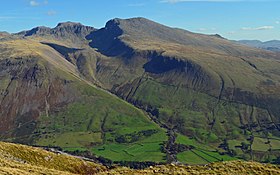Sca Fell
| Scafell | |
|---|---|

The Scafell massif from Middle Fell. Scafell is on the right. From this angle Scafell appears higher than Scafell Pike.
|
|
| Highest point | |
| Elevation | 964 m (3,163 ft) |
| Prominence | 133 m (436 ft) |
| Parent peak | Scafell Pike |
| Listing | Hewitt, Wainwright, Nuttall |
| Coordinates | 54°26′53″N 3°13′30″W / 54.448°N 3.225°WCoordinates: 54°26′53″N 3°13′30″W / 54.448°N 3.225°W |
| Geography | |
| Location | Cumbria, England |
| Parent range | Lake District, Southern Fells |
| OS grid | NY206064 |
| Topo map | OS Landrangers 89, 90, Explorer OL6 |
| Listed summits of Sca Fell | ||||
| Name | Grid ref | Height | Status | |
|---|---|---|---|---|
| Symond's Knott | NY207067 | 959 m (3,146 ft) | Nuttall | |
Scafell (/ˈskɔːfəl/ or /skɑːˈfɛl/; also spelled Sca Fell, previously Scawfell) is a mountain in the English Lake District, part of the Southern Fells. Its height of 964 metres (3,162 ft) makes it the second-highest mountain in England after its neighbour Scafell Pike, from which it is separated by Mickledore col.
Scafell stands between Wasdale in the west and upper Eskdale to the east. The highest part of the fell is a ridge running south from Mickledore as far as Slight Side, which is counted as a separate fell by most guidebooks. Despite regarding Slight Side as a separate entity, Wainwright included the wide upland area beyond it to the south west as a part of Scafell. More modern guides have partitioned the plateau off as a further independent top, Great How.
The opposing flanks of Scafell are entirely different in character. Smooth slopes, lacking vegetation at higher levels but also devoid of any real interest, run down toward Burnmoor and the head of Wastwater. But on the east crags looming impressively over upper Eskdale, and on the north side Scafell Crag provides some the finest rock scenery in the Lake District.
From the narrow ridge of Mickledore the northern face of Scafell rises precipitously, an unusually complete barrier to progress along a Lakeland ridge, which frustrates many ridge walkers who find that this is a cliff for rock climbers only. At the top of the rise from Mickledore is Symonds Knott (3,146 ft), the northern top. The wall of crags — Scafell Crag to the west and the East Buttress above the Eskdale side of Mickledore — has two main weaknesses. Running laterally across Scafell Crag is Lord's Rake, a scree-filled chute with several intermediate cols. It has two upper entrances onto the saddle separating Symonds Knott from the main summit. Formerly passable as a scramble, Lord's Rake suffered from a serious rock fall in 2002 — with subsequent further falls — and recent guidebooks do not consider it a viable route, although it is gradually becoming more stable. The block that was bridged across the head of Lord's Rake collapsed into the gully in July 2016, leaving several small unstable blocks behind, which can be avoided with care. The access to West Wall Traverse is clear of debris. The second breach in the crags is Broad Stand, a series of sloping steps which drop down from Symonds Knott almost to Mickledore; however, these steepen immediately above Mickledore and cannot be negotiated safely except by rock-climbers. The main summit stands a little to the south of the saddle, all around being a sea of stones. An easy ridge then steps down southward over Long Green to Slight Side. On the east are Cam Spout Crag and the fine high waterfall after which it is named.
...
Wikipedia

